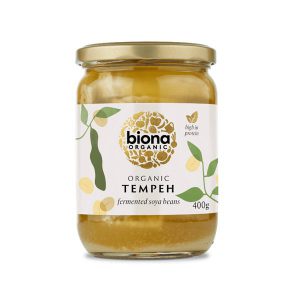
- Readers Rating
- No Rating Yet!
- Your Rating
Tempeh is a food that has gained popularity in recent years, especially among those who follow vegan or vegetarian diets. Despite being a relatively new ingredient in Western cuisine, its origin dates back thousands of years in Asian cooking. This fermented superfood, with its firm texture and earthy flavor, has won over tables around the world thanks to its numerous nutritional properties, its versatility in the kitchen, and its unique contribution to health.
What is tempeh?
Tempeh is a plant-based product made from fermented soybeans, although it can also be made with other types of legumes or grains. Traditionally, tempeh is prepared by cooking soybeans and then fermenting them with a special fungus culture from the Rhizopus genus. During this fermentation process, the soybeans are compacted into a firm block, resulting in a dense and slightly chewy texture.
This fermented food has a slightly earthy and nutty flavor, with a sweet and sour touch due to the fermentation. It is often described as more flavorful and with a more pleasant texture than tofu, another soy-based product, and is highly appreciated for its ability to absorb the flavors of spices and seasonings with which it is cooked.
Tempeh originated in Indonesia, where it is a staple food and is consumed in various forms, from main dishes to snacks. Its fermentation process not only enhances the taste and texture of the soybeans but also increases their nutritional value, making it an excellent source of protein and other essential nutrients.
Origin of Tempeh
Tempeh has a long history in Southeast Asian cuisine, particularly in Indonesia, where it is believed to have been created over a thousand years ago. Although the exact details of its origin are unclear, it is likely that it was discovered accidentally when cooked soybeans were exposed to fungi that thrive in the region’s tropical climate.
On the island of Java, tempeh has been consumed for generations and is considered an integral part of the local diet. Its popularity likely grew due to the need for affordable alternative protein sources in a region where meat was not always available or was too expensive. Over time, soybean fermentation became a refined technique, and tempeh became a staple food in many parts of Southeast Asia.
Tempeh did not reach the West until the 20th century, when interest in vegetarian and vegan diets began to rise. Health and wellness advocates quickly embraced it for its impressive nutritional benefits and its ability to serve as a satisfying meat substitute.

Nutritional Properties of Tempeh
One of the reasons tempeh has become so popular is due to its impressive nutritional profile. Below are some of its most notable properties:
- High in Complete Proteins: Tempeh is one of the best sources of plant-based protein. A 100-gram serving of tempeh contains around 18 to 20 grams of protein, making it an ideal option for those looking to increase their protein intake without resorting to animal products. Unlike many other plant-based protein sources, tempeh is a complete protein, meaning it contains all nine essential amino acids that the human body needs to function properly.
- Rich in Fiber: Thanks to its whole soybean content and other grains, tempeh is an excellent source of dietary fiber. Fiber is essential for digestive health, as it helps regulate bowel movements and promotes the growth of beneficial bacteria in the gut. This may also reduce the risk of chronic diseases such as colon cancer.
More properties…
- Source of Vitamins and Minerals: Tempeh is a great source of several important micronutrients. It is particularly rich in calcium, iron, magnesium, phosphorus, and potassium. These minerals are essential for bone health, muscle function, blood pressure regulation, and energy production. Moreover, the fermentation process of tempeh enhances the bioavailability of these nutrients, meaning the body can absorb them more easily.
- Natural Probiotics: Since tempeh is a fermented food, it contains probiotics, which are beneficial bacteria for the gut. Probiotics improve digestive health, strengthen the immune system, and help combat inflammation in the body. Additionally, fermented foods are known to promote a healthy balance of bacteria in the gut microbiome, which can have broader health benefits.
- Low in Carbohydrates and Saturated Fats: Tempeh is low in carbohydrates and has a moderate fat content, most of which are healthy unsaturated fats. Additionally, it contains very little saturated fat, making it an excellent option for those looking to maintain heart health or reduce their intake of animal fats.

Uses of Tempeh in Cooking
Tempeh is incredibly versatile in the kitchen and can be used in a wide variety of dishes. Its firm texture and ability to absorb flavors make it an excellent meat alternative in vegan and vegetarian recipes. Below, we explore some common ways to cook and enjoy tempeh.
- Grilled or Baked: Tempeh can be marinated with various sauces, such as soy sauce, garlic, ginger, and lemon, and then grilled or baked. This method is ideal for achieving a crispy, flavorful texture, perfect for adding to salads, pasta dishes, or simply as a main dish served with vegetables.
- Stir-Fried: Tempeh cut into cubes or strips is perfect for stir-frying in a wok along with vegetables, tofu, or noodles. You can add teriyaki or soy sauce for an authentic Asian flavor. Stir-fries are quick to prepare and an excellent option for a nutritious and fast meal.
- Fried or Breaded: For a crispier option, tempeh can be breaded and lightly fried. This preparation resembles chicken nuggets or meat strips, making it an appealing vegan alternative for those who enjoy crispy food. Serve these fried strips with a sweet and sour or barbecue sauce.
More uses of tempeh…
- In Stews or Soups: Tempeh is also great for incorporating into stews or soups. Its ability to absorb flavors makes it an excellent ingredient for dishes like vegan chili, noodle soups, or curry. Simply add tempeh pieces at the end of cooking so they soak up the flavors of the broth or sauce.
- Sandwiches and Wraps: Tempeh is a great substitute for bacon or cold cuts in sandwiches. You can sauté it with spices and then add it to wraps or sandwiches along with lettuce, tomato, avocado, and sauces for a quick and delicious meal.
- Vegan Burgers: Crumbled tempeh can be mixed with other ingredients like breadcrumbs, spices, and vegetables to form vegan burgers. These patties have a firm, hearty texture, making them a closer alternative to meat than other plant-based options.
Similar Foods to Tempeh
Tempeh is not the only plant-based food that offers a healthy source of protein and a meaty texture. Several similar foods are also part of vegan or vegetarian diets. Below are some examples:
1. Tofu
Tofu is perhaps the most well-known meat substitute, also made from soybeans. Unlike tempeh, tofu has a much softer texture and comes in various forms, from silken to firm. It’s a versatile ingredient that absorbs flavors well but lacks the probiotic content of tempeh, as it is not fermented.
2. Seitan
Seitan, also known as “wheat meat,” is a product made from wheat gluten with a texture remarkably similar to meat. It is often used in vegan recipes as a substitute for chicken or beef. Although high in protein, it is not suitable for those with gluten intolerance.
3. Miso
Miso is another form of fermented soy, but it is more commonly used as a condiment or base for soups. It is a fermented ingredient rich in probiotics, although its texture is not comparable to tempeh.
4. Natto
Natto is a Japanese fermented soybean food. It is less well-known outside of Japan due to its intense flavor and smell, which may not appeal to everyone. Despite its unique profile, natto is incredibly nutritious and a rich source of vitamin K2.

Tempeh is much more than just a simple meat substitute: it is a food rich in history, flavor, and nutritional benefits. Its high content of protein, fiber, vitamins, and minerals, along with its natural probiotics, makes it an excellent addition to any diet, whether vegan or not. Furthermore, its versatility in the kitchen allows for the creation of delicious and healthy dishes that cater to different tastes and cooking styles.
Whether you enjoy it grilled, in salads, in burgers, or as part of a stir-fry, tempeh is a food that deserves a place on your table. With its wealth of nutrients and its ability to improve gut and overall health, it’s an ideal option for those seeking high-quality plant-based alternatives in their daily diet.
